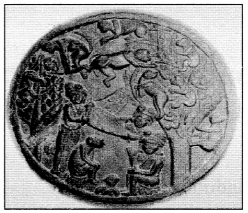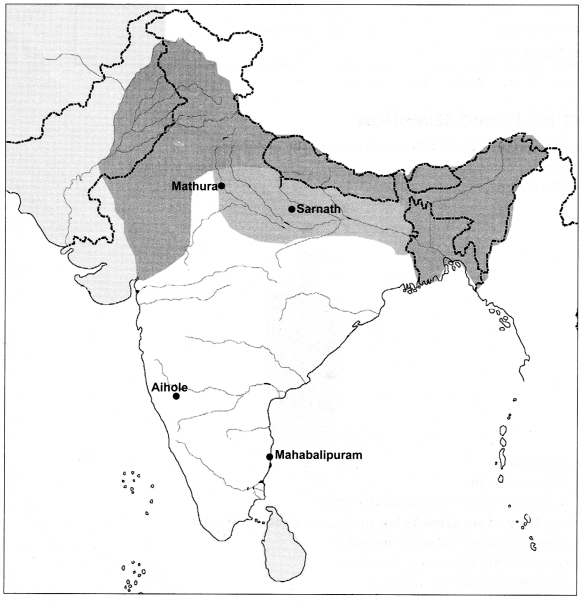The Earth in the Solar System Class 6 History Chapter 12 Extra Questions and Answers Social Science CBSE Pdf free download are part of Extra Questions for Class 6 Social Science. Here we have given NCERT Extra Questions for Class 6 Social Science SST History Chapter 12 The Earth in the Solar System.
You can also practice NCERT Solutions for Class 6 History Chapter 12 Questions and Answers on LearnInsta.com.
Class 6 History Chapter 12 Extra Questions and Answers Buildings, Paintings, and Books
Buildings, Paintings, and Books Class 6 Extra Questions and Answer History Chapter 12 Very Short Answers Type
Question 1.
Why was Amaravati famous?
Answer:
Amaravati was famous because it is a place where a magnificent stupa once existed.
Question 2.
Where is Sanchi stupa situated?
Answer:
In Madhya Pradesh.
Question 3.
When was Sanchi stupa made?
Answer:
Probably it was made during the Ashoka period.
Question 4.
What do you know about ‘pradakshina patha’?
Answer:
Around the stupa, the path was known as the ‘pradakshina patha’. Devotees walked around the stupa in a clockwise direction, as a mark of devotion.
Question 5.
Name the two Tamil epics?
Answer:
Silappadikaram and Manimekalai are two famous epics.
Question 6.
Who wrote Silappadikaram?
Answer:
Ilango was the writer of Silappadikaram.
Question 7.
Who composed Manimekalai?
Answer:
Manimekalai epic was composed by Sattanar.
Question 8.
Who were the deities worshipped during the period?
Answer:
Deities such as Vishnu, Shiva and Durga were worshipped.
Question 9.
Who spent the money for temples and stupas?
Answer:
Most probably, the King or Queen spent the money for temples and stupas.
Question 10.
Who made Iron Pillar and when?
Answer:
Iron Pillar was made by Chandra who probably belonged to the Gupta Dynasty. It was made about 1500 years ago in Delhi.
Question 11.
What is the most amazing feature of Iron Pillar?
Answer:
The most amazing feature of Iron Pillar is that it has not rusted in all these years.
Question 12.
What do you mean by word ‘stupa’?
Answer:
Stupa means a mound.
Question 13.
Why do the devotees move into clockwise direction?
Answer:
The devotees move into clockwise direction to show their devotion.
Question 14.
Why was Amravati famous?
Answer:
Amravati was famous because there were magnificent stupas.
Question 15.
Which deities were worshipped in the earliest temples of Hindus?
Answer:
Vishnu, Shiva and Durga were worshipped in the earliest temples of Hindus.
Question 16.
What do you mean by garbhagriha of temples?
Answer:
The main or central place of temples is called garbhagriha where image of deity is placed for worship.
Question 17.
What do you mean by ‘shikhara’of temples ?
Answer:
A tower built on the top of the garbhagriha of temple. This tower is called shikhara. This indicates about a sacred place.
Question 18.
Who wrote the original ‘Ramayana’?
Answer:
Ramayana was composed by Valmiki. This was in Sanskrit language.
Question 19.
What are the differences between the Vedas and the Puranas?
Answer:
Women and Shudras were not allowed to read the Vedas but the Puranas could be read by all.
Question 20.
Give the name of book written by Aryabhata.
Answer:
The book named Aryabhatiyam was written by Aryabhata.
Question 21.
Who invented ‘zero’ in mathematics?
Answer:
‘Zero’ was invented by Aryabhata.
Question 22.
By whom was firstly the symbol of zero adopted?
Answer:
It was adopted by Arabs and then spread to Europe.
Question 23.
Who invented paper and when?
Answer:
Paper was invented in China by Cai Lun about 1900 years ago.
Question 24.
Where is the story of the monkey king shown?
Answer:
This story is shown on a piece of sculpture found from a stupa at Bharhut in central India.
Buildings, Paintings, and Books Class 6 Extra Questions and Answer History Chapter 12 Short Answers Type
Question 1.
Describe about the iron pillar situated at Mehrauli.
Answer:
The iron pillar is in Mehrauli, Delhi and is a remarkable example of the skill of Indian crafts persons. It is made of iron, 7.2. m high, and weighs over 3 tonnes. It was made about 1500 years ago. There is an inscription on the pillar mentioning a ruler named Chandra who probably belonged to the Gupta Dynasty. The pillar has not rusted in all these years.
Question 2.
What did the small box placed at the centre of the stupa contain?
Answer:
This may contain bodily remains such as teeth, bones or ashes of the Buddha or his followers, or things they used, as well as precious stones and coins.
Question 3.
What is pradakshina patha?
Answer:
A path was laid around the stupa known as the pradakshina patha. This was surrounded with railings. Entrance of the path was through gateways.
Question 4.
Why is Ajanta famous?
Answer:
Ajanta is famous because there are several caves which were hollowed out of the hills. Most of these were monasteries for Buddhist monks. Some of them were decorated with paintings.
Question 5.
What are the main features of Ajanta paintings?
Answer:
The main features of Ajanta paintings Eire as follows:
- Ajanta is a place where several caves and paintings were found, which are world-famous.
- The caves are dark inside and therefore, probably the work of making the paintings was done in the light of torches.
- The colours were made of plants and minerals.
- The colours are still glowing even after 1500 years.
Question 6.
Write a short note on Meghaduta composed by Kalidasa.
Answer:
Kalidasa’s Meghaduta is one the best poems that is famous from centuries. It was written in Sanskrit and is the best literary creation. Kalidasa was working in the Gupta regime and therefore, much possibilities that it might have been composed during the period.
In this poem, the monsoon cloud is imagined to be a messenger between lovers who are separated from one another. He stated a description of monsoon in the poem, where clouds, breeze, fragrance in the air have been described.
Buildings, Paintings, and Books Class 6 Extra Questions and Answer History Chapter 12 Long Answers Type
Question 1.
Write a short note on the epic named Silappadikaram.
Answer:
The epic Silappadikaram was composed by a poet named Ilango. This is a Tamil epic and was composed around 1800 years ago. It is a story of a merchant named Kovalan, who lived in Puhar and fell in love with a courtesan named Madhavi. He ignored his wife Kannagi.
Later, he and Kannagi who was his wife, left Puhar and went to Madurai, where he was wrongly accused of theft by the court jeweller of the Pandya king. The king sentenced Kovalan to death. Kannagi, who still loved him, was full of grief and anger at this injustice, and destroyed the entire city of Madurai.
Question 2.
Write a short note on stupa.
Answer:
Stupa means a mound. There are several kinds of stupas-round and tall, big and small. But these have certain common features, generally there is a small box which is known as ‘relic casket’ and placed at the centre or heart of the stupa. This may contain bodily remains such as teeth, bone or ashes of the Buddha or his followers or things they used, as well as precious stones and coins.
Around the stupa, the path is known as the ‘pradakshina patha’. Devotees walked around the stupa in a clockwise direction, as a mark of devotion. Amaravati was a place where a magnificent stupa once existed.
Question 3.
What are common features in various stupas?
Answer:
Common features in stupas are:
- Generally there is a small box which is known as ‘relic casket’ and placed at the centre or heart of the stupa. This may contain bodily remains such as teeth, bone or ashes of the Buddha or his followers or things they used, as well as precious stones and coins.
- Around the stupa the path is known as the ‘pradakshina patha’ and is found in most of stupas.
Question 4.
Write a short note on paper production and its uses.
Answer:
The use of paper has become an integral part of our life. It was invented in China about 1900 years ago. Cai Lun is the man who invented paper. As a process, plants and their bark are dripped in the water, then beaten or pressed, drained and pulp is dried to create paper. Paper is used in many activities of daily life which can be summarized as:
- Reading: All books, magazines, periodicals, newspapers, publicity materials are in form of paper etc.
- Writing: Copies, registers, entry books, log books, note pads, note slips, diary, letter heads, noting etc.
- Packaging: Making of the different type of cartons etc.
- Making decorative items: such as flowers, bouquets etc.
- Playing items: Printed ludo, chess, kite etc.
- Hygienic items: Such as tissue papers, napkins etc.
Question 5.
How do we know about the story of the monkey king? Describe.
Answer:
This story is shown on a piece of sculpture found from a stupa at Bharhut in Central India. This piece of sculpture tells an interesting story. Once upon a time, there was a great monkey king, who lived on the banks of the Ganga in Himalayas. Monkey king had 80,000 followers. They fed on the fruits of a special mango tree, which were very sweet. One day a mango fell into the river and reached to Varanasi.
In Varanasi this mango is found by the king, when he was bathing. He gave order to the court men that they find out about the tree. At night, the king discovered that the monkeys were also feasting on the fruit, and decided to kill them. On the other hand, king of the monkeys worked out a plan to save his followers. And ultimately he got success in saving his followers but monkey king fell down and died. The king of Varanasi mourned his death and paid him full respect.
Picture Based Questions Class 6 History Chapter 12 Buildings, Paintings, and Books
Question 1.
Look the picture given below and answer the questions:
(i) Give the name.
(ii) Where is located?
(iii) Who built it?

Answer:
(i) Iron Pillar
(ii) Mehrauli, Delhi
(iii) Chandra, a ruler of the Gupta Dynasty.
Question 2.
Look at the picture given below and answer the questions:
(i) Where is this piece of sculpture found?
(ii) Give the tittle of the story made on it.
(iii) What do we learn from this story?

Answer:
(i) This picture is found in a stupa situated at Bharhut.
(ii) The tittle of the story is “The story of the monkey king”.
(iii) This story teaches us that a king should protect and save its people in all the circumstances even at the cost of his own life.
Map-Based Questions Class 6 History Chapter 12 Buildings, Paintings, and Books
Question 1.
Find following places in map.
(a) Sarnath
(b) Mathura
(c) Mahabalipuram
(d) Aihole
Answer:
